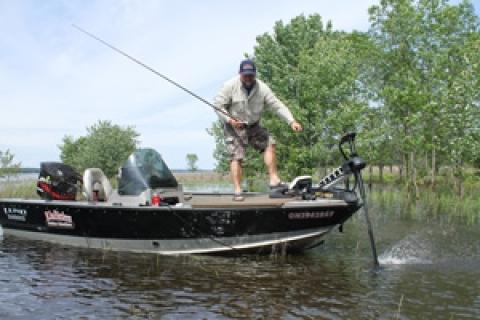
 Baitcast reels are designed to provide either power or speed. Since we face multiple scenarios throughout a day of fishing, uncovering the facts on gears can make our life on the water much easier and more productive.
Baitcast reels are designed to provide either power or speed. Since we face multiple scenarios throughout a day of fishing, uncovering the facts on gears can make our life on the water much easier and more productive.
An example of a gear ratio is 6.4:1. The last number represents one complete turn of the reel handle — the first describes how many times the spool rotates. In this case, 6.4 spool revolutions for each crank of the handle.
High gear ratios (7.1:1) are built for speed. Line can be retrieved quickly and efficiently. A reel of this style works best for fast presentations, such as burning spinnerbaits and lipless crankbaits, or when working areas that require quick pitches or flips to specific spots, like docks, cane, or weed clumps.
Low gear ratios (5.4:1) signify power. Effort and line retrieval is greatly reduced when reeling, making it a good choice when tossing high resistance lures, namely deep diving crankbaits or oversized spinnerbaits.
A baitcast reel sporting a ratio of 6.4.1 is your best bet for reaping the rewards of both power and speed. It's the "all purpose" model in the baitcast world.
Thrust (defn.) - The power rating of an electric trolling motor that is measured in pounds.
A trolling motor is an indispensable piece of equipment for those serious about fishing. Choose the wrong "thrust", however, and you might as well be treading water.
Here are five simple rules for narrowing down the correct thrust:
- You will need a minimum of 5 pounds of thrust for every 350 pounds of load. This latter figure includes boat, equipment, gas and people.
- A boat measuring 14 feet in length requires 32 pounds of minimum motor thrust under "normal" fishing situations; 55 pounds for an 18-foot craft.
- Those who fish in adverse conditions — big water, high winds, heavy vegetation, long hours — should choose a thrust rating considerably higher than those recommended.
- Buy as much power as you can afford, within reason. Lowering speed/power is always possible with a high-thrust motor — upgrading power on an undersized unit is not.
- Don't cut corners. A higher thrust motor may cost more initially, but the extended life (no need to upgrade) and lack of frustrations are definitely priceless.
- 4855 views

